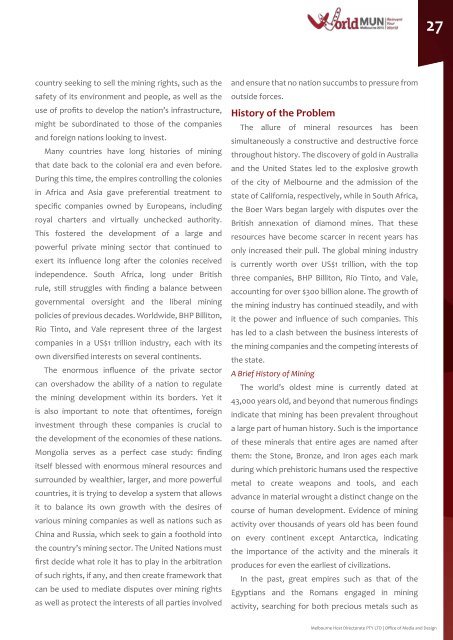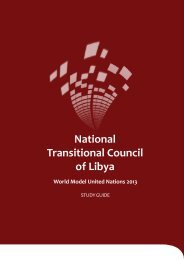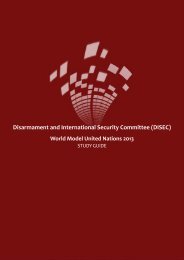SPECPOL - World Model United Nations
SPECPOL - World Model United Nations
SPECPOL - World Model United Nations
Create successful ePaper yourself
Turn your PDF publications into a flip-book with our unique Google optimized e-Paper software.
country seeking to sell the mining rights, such as the<br />
safety of its environment and people, as well as the<br />
use of profits to develop the nation’s infrastructure,<br />
might be subordinated to those of the companies<br />
and foreign nations looking to invest.<br />
Many countries have long histories of mining<br />
that date back to the colonial era and even before.<br />
during this time, the empires controlling the colonies<br />
in Africa and Asia gave preferential treatment to<br />
specific companies owned by Europeans, including<br />
royal charters and virtually unchecked authority.<br />
This fostered the development of a large and<br />
powerful private mining sector that continued to<br />
exert its influence long after the colonies received<br />
independence. South Africa, long under British<br />
rule, still struggles with finding a balance between<br />
governmental oversight and the liberal mining<br />
policies of previous decades. <strong>World</strong>wide, BHP Billiton,<br />
Rio Tinto, and Vale represent three of the largest<br />
companies in a US$1 trillion industry, each with its<br />
own diversified interests on several continents.<br />
The enormous influence of the private sector<br />
can overshadow the ability of a nation to regulate<br />
the mining development within its borders. Yet it<br />
is also important to note that oftentimes, foreign<br />
investment through these companies is crucial to<br />
the development of the economies of these nations.<br />
Mongolia serves as a perfect case study: finding<br />
itself blessed with enormous mineral resources and<br />
surrounded by wealthier, larger, and more powerful<br />
countries, it is trying to develop a system that allows<br />
it to balance its own growth with the desires of<br />
various mining companies as well as nations such as<br />
China and Russia, which seek to gain a foothold into<br />
the country’s mining sector. The <strong>United</strong> <strong>Nations</strong> must<br />
first decide what role it has to play in the arbitration<br />
of such rights, if any, and then create framework that<br />
can be used to mediate disputes over mining rights<br />
as well as protect the interests of all parties involved<br />
and ensure that no nation succumbs to pressure from<br />
outside forces.<br />
History of the Problem<br />
The allure of mineral resources has been<br />
simultaneously a constructive and destructive force<br />
throughout history. The discovery of gold in Australia<br />
and the <strong>United</strong> States led to the explosive growth<br />
of the city of Melbourne and the admission of the<br />
state of California, respectively, while in South Africa,<br />
the Boer Wars began largely with disputes over the<br />
British annexation of diamond mines. that these<br />
resources have become scarcer in recent years has<br />
only increased their pull. The global mining industry<br />
is currently worth over US$1 trillion, with the top<br />
three companies, BHP Billiton, Rio Tinto, and Vale,<br />
accounting for over $300 billion alone. The growth of<br />
the mining industry has continued steadily, and with<br />
it the power and influence of such companies. This<br />
has led to a clash between the business interests of<br />
the mining companies and the competing interests of<br />
the state.<br />
A Brief History of Mining<br />
The world’s oldest mine is currently dated at<br />
43,000 years old, and beyond that numerous findings<br />
indicate that mining has been prevalent throughout<br />
a large part of human history. Such is the importance<br />
of these minerals that entire ages are named after<br />
them: the Stone, Bronze, and Iron ages each mark<br />
during which prehistoric humans used the respective<br />
metal to create weapons and tools, and each<br />
advance in material wrought a distinct change on the<br />
course of human development. Evidence of mining<br />
activity over thousands of years old has been found<br />
on every continent except Antarctica, indicating<br />
the importance of the activity and the minerals it<br />
produces for even the earliest of civilizations.<br />
in the past, great empires such as that of the<br />
egyptians and the Romans engaged in mining<br />
activity, searching for both precious metals such as<br />
27<br />
Melbourne Host Directorate PTY LTD | Office of Media and Design

















